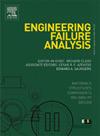蒸汽侵蚀和湿硫腐蚀共同作用下输硫夹套管道失效机理研究
IF 4.4
2区 工程技术
Q1 ENGINEERING, MECHANICAL
引用次数: 0
摘要
在天然气净化装置中,双层夹套管道对硫磺的经济、高效、安全输送至关重要。然而,四川和重庆地区的一些工厂在日常运行中遇到了液体硫套管道穿孔和泄漏问题,阻碍了长期稳定运行。以某净化装置为例,对其运行不到两年的夹套管道进行了全面的失效分析。采用物化性能分析、XRD、XPS、SEM、EDS、金相分析等技术。分析表明,管道化学成分符合标准要求,微观结构正常,材料质量令人满意。腐蚀形貌和产物分析显示为内外腐蚀穿孔。结合实际工况,假设管道内外壁在液硫、硫蒸气、水蒸气环境下的腐蚀和冲击应力导致薄弱区形成。在此基础上,建议进行设计优化和工艺参数调整,以加强此类管道的安全运行和管理。本文章由计算机程序翻译,如有差异,请以英文原文为准。
Failure mechanism of sulfur transport jacketed pipeline induced by the combined effects of steam erosion and wet sulfur corrosion
Double-layer jacketed pipelines are crucial for the economical, efficient, and safe transportation of sulfur in natural gas purification plants. However, several plants in the Sichuan and Chongqing regions have faced perforation and leakage issues with their liquid sulfur jacketed pipelines during routine operations, hindering long-term stable operation. Taking a specific purification plant as a case study, a comprehensive failure analysis was conducted on its jacketed pipeline, which had been in operation for less than two years. Techniques such as physical and chemical property analysis, XRD, XPS, SEM, EDS, and metallographic examination were employed. The analysis showed that the pipeline’s chemical composition met the standard requirements, its microstructure was normal, and material quality was satisfactory. Corrosion morphology and product analysis revealed internal-to-external corrosion perforation. Considering the actual operating conditions, it was hypothesized that corrosion and impact stress on the inner and outer walls of the pipeline in the liquid sulfur, sulfur vapor, and water vapor environment led to the formation of a weak zone. Based on these findings, design optimization and process parameter adjustments are recommended to enhance the safe operation and management of such pipelines.
求助全文
通过发布文献求助,成功后即可免费获取论文全文。
去求助
来源期刊

Engineering Failure Analysis
工程技术-材料科学:表征与测试
CiteScore
7.70
自引率
20.00%
发文量
956
审稿时长
47 days
期刊介绍:
Engineering Failure Analysis publishes research papers describing the analysis of engineering failures and related studies.
Papers relating to the structure, properties and behaviour of engineering materials are encouraged, particularly those which also involve the detailed application of materials parameters to problems in engineering structures, components and design. In addition to the area of materials engineering, the interacting fields of mechanical, manufacturing, aeronautical, civil, chemical, corrosion and design engineering are considered relevant. Activity should be directed at analysing engineering failures and carrying out research to help reduce the incidences of failures and to extend the operating horizons of engineering materials.
Emphasis is placed on the mechanical properties of materials and their behaviour when influenced by structure, process and environment. Metallic, polymeric, ceramic and natural materials are all included and the application of these materials to real engineering situations should be emphasised. The use of a case-study based approach is also encouraged.
Engineering Failure Analysis provides essential reference material and critical feedback into the design process thereby contributing to the prevention of engineering failures in the future. All submissions will be subject to peer review from leading experts in the field.
 求助内容:
求助内容: 应助结果提醒方式:
应助结果提醒方式:


